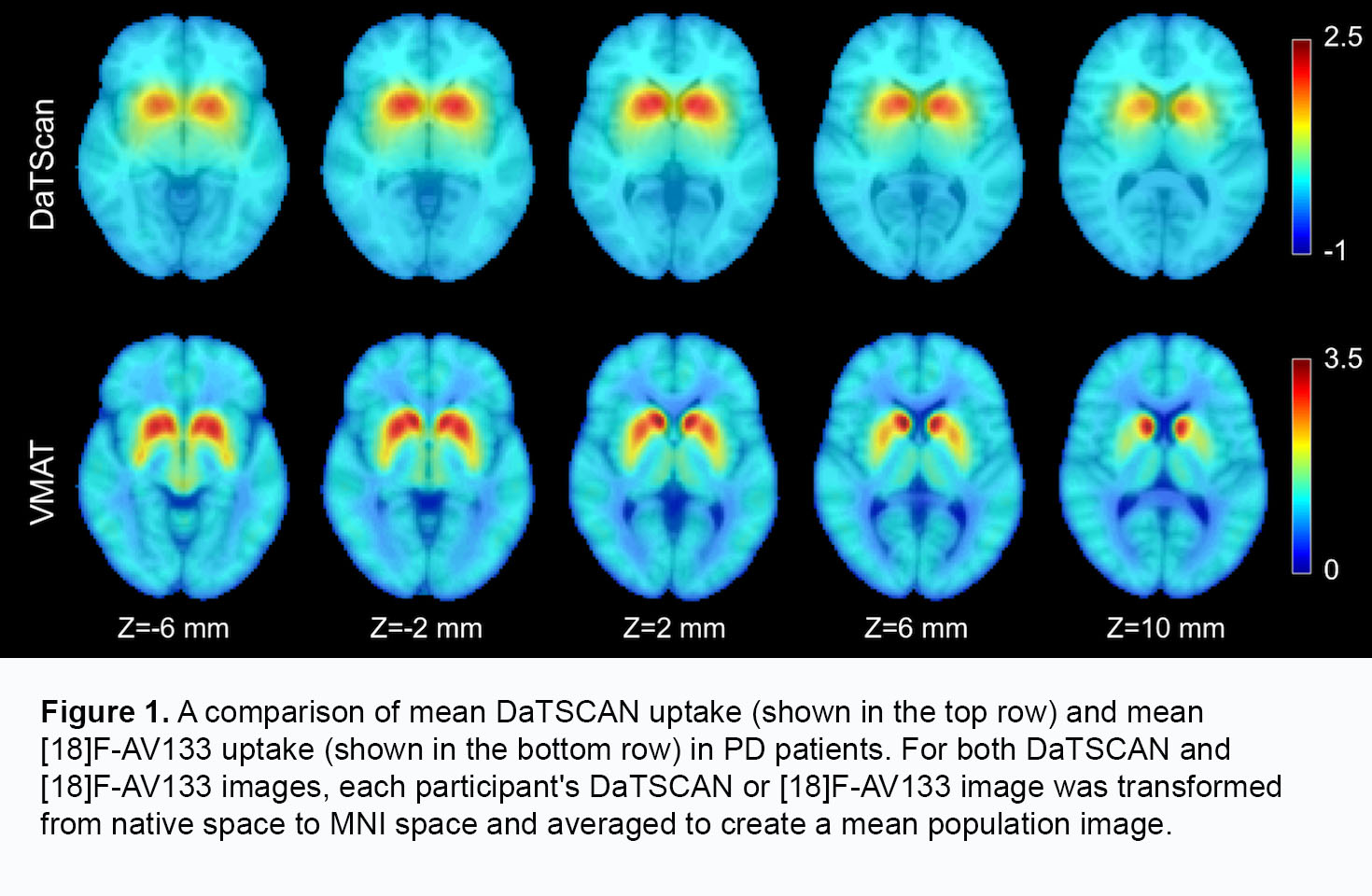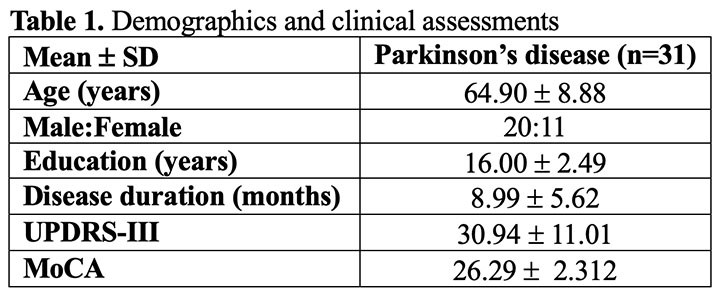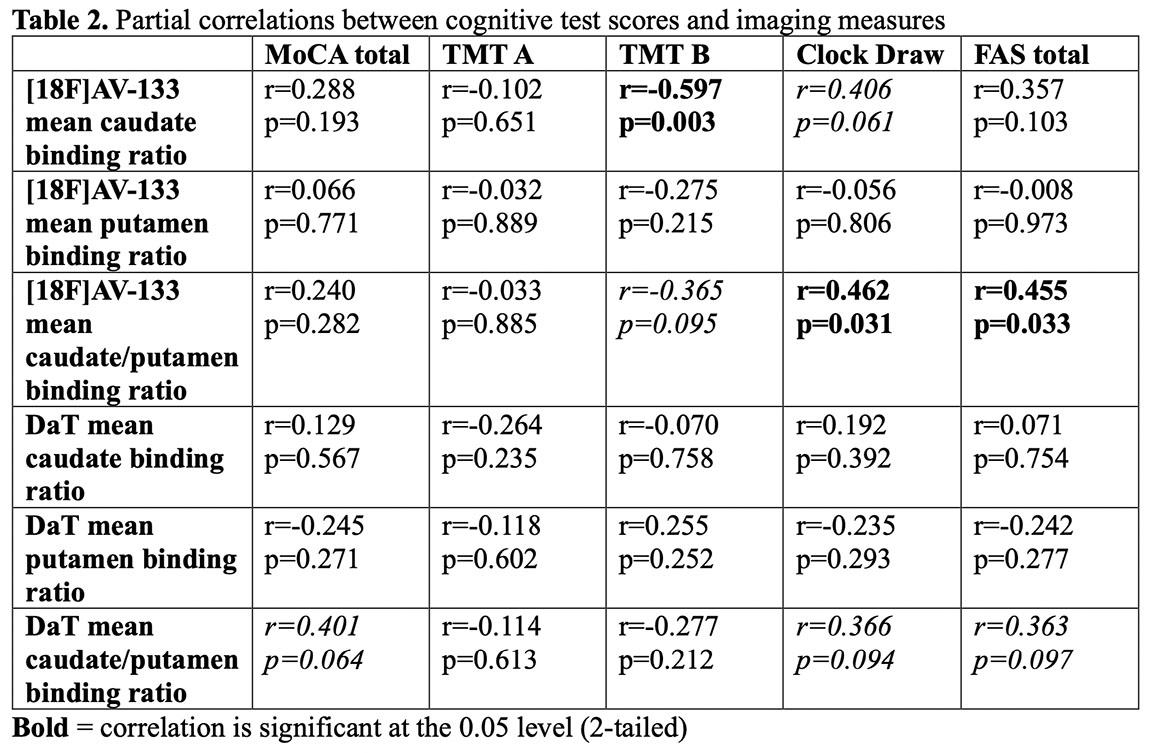Category: Parkinson's Disease: Neuroimaging
Objective: To evaluate the association between cognitive deficits and striatal vesicular monoamine transporter type 2 (VMAT2) binding in participants with Parkinson’s disease (PD) using [18F]AV-133 tracer positron emission tomography (PET) scans from the Parkinson’s Progression Marker’s Initiative (PPMI)
Background: Cognitive impairment is common in PD and 50-80% of patients develop dementia as PD progresses. Dopaminergic and monoaminergic dysfunction are potential mechanisms for cognitive decline in PD. Presynaptic and synaptic dopamine function can be evaluated using VMAT2 PET imaging and 123I-FP-CIT SPECT imaging (DaTSCAN), respectively. The relationship between cognitive deficits and striatal dopamine dysfunction as measured by VMAT2 PET imaging has not been fully established.
Method: Data was obtained from the PPMI database (www.ppmi-info.org/data). 31 PD participants had MRI, DaTSCAN, and [18F]AV-133 PET (VMAT2) scans at the baseline visit. PET and SPECT scans were registered to each participant’s T1-weighted MRI and partial volume corrected (figure 1). VMAT2 and DaT binding ratios (VBR and DBR) in the caudate and putamen were extracted from the VMAT2 and DaTSCAN images, respectively. Montreal Cognitive Assessment (MoCA), Trail Making Test Parts A & B (TMT A & TMT B), Clock Draw and FAS were used to evaluate frontal-executive cognitive deficits. Partial correlations were used to assess the relationship between cognitive test scores and mean caudate and putamen VBR and DBR while adjusting for age, education, disease duration and Unified Parkinson’s Disease Rating Scale part 3 score (UPDRS-III) with a p-value threshold of 0.05.
Results: Demographic and clinical assessments are shown in table 1. A significant negative correlation between TMT B and mean VBR was seen in the caudate (r=-0.597, p=0.003) but not in the putamen (table 2). Mean caudate/putamen VBR showed significant positive correlations with clock draw (r=0.462, p=0.031) and total FAS score (r=0.455, p=0.033). There were no significant associations between TMT B, clock draw and FAS with DBR. There were no significant correlations between MoCA and TMT A with VBR or DBR.
Conclusion: Striatal dopamine dysfunction in the caudate as measured by [18F]AV-133 PET imaging may be a promising marker associated with executive cognitive dysfunction in early PD.
Figure 1
Table 1
Table 2
To cite this abstract in AMA style:
K. Hwang, J. Langley. Evaluating the association between cognitive impairment and striatal VMAT2 binding using [18F]AV-133 PET in Parkinson’s disease [abstract]. Mov Disord. 2024; 39 (suppl 1). https://www.mdsabstracts.org/abstract/evaluating-the-association-between-cognitive-impairment-and-striatal-vmat2-binding-using-18fav-133-pet-in-parkinsons-disease/. Accessed October 17, 2025.« Back to 2024 International Congress
MDS Abstracts - https://www.mdsabstracts.org/abstract/evaluating-the-association-between-cognitive-impairment-and-striatal-vmat2-binding-using-18fav-133-pet-in-parkinsons-disease/



